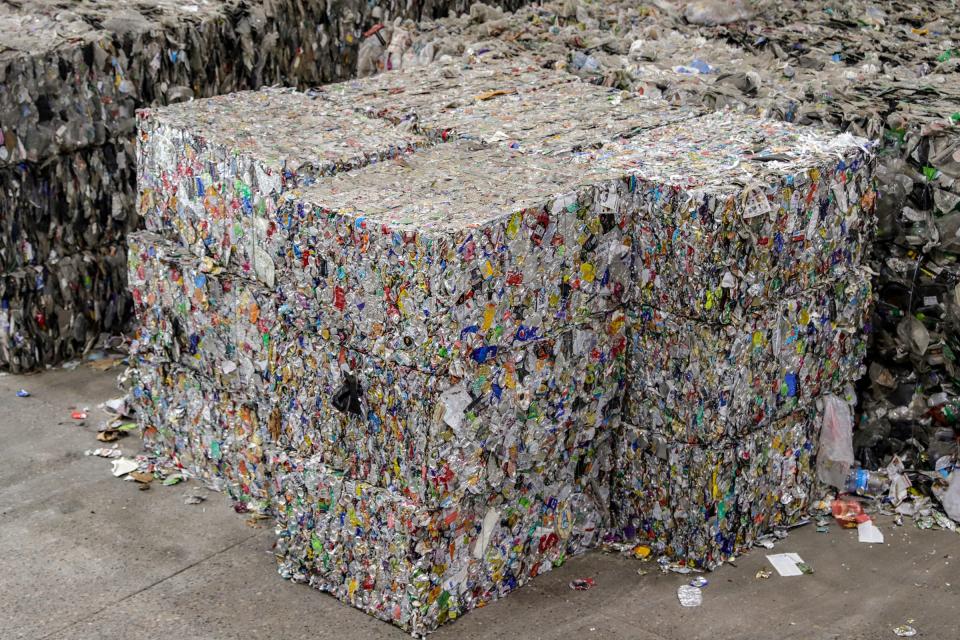NC Answers: What happens to the stuff we put in our recycling bins?

Have a question about the Tar Heel State? The USA TODAY Network's NC News Team can try to find you an answer. Email us at NCNewsTeam@Gannett.com with your questions and tips.
Question: What happens to the items we put in our recycling bins?
Short answer: Some of it does end up in landfills, but a good portion enters a global commodities network that sends materials from our old cans, cardboard boxes, and milk jugs across the state and around the world.
What does and doesn’t get recycled is determined more by economics than the environment, and recent international trends have upended how the process works.
Longer answer: In North Carolina, local governments are responsible for garbage and recycling services. Last year, more than half of the state's counties, cities, towns, and villages offered curbside recycling. This represented a slight decline from the previous year as several municipalities - including cities like Gastonia - stopped curbside pick-ups.
Upon being collected and tossed into the back of recycling trucks, objects are taken to one of 17 materials recovery facilities in the state. Known as MRFs (and pronounced like the name “Murph”), these recovery facilities are typically run by private companies that contract with local governments.
More: NC Answers: What abortion restrictions have passed in North Carolina? Are more on the way?
Instead of focusing on everything that can scientifically be recycled, MRFs concentrate on materials that earn money.
When sorted, cleaned, broken down, and combined in large quantities, many everyday materials garner big bucks on commodities markets. Aluminum is currently selling for nearly $3000 a metric ton. Steel sells for $5,800, and tin for more than $35,000. There’s also demand for mixed paper, rubber, glass, certain plastics, and more.
Modern MRFs separate materials through a highly mechanized process that involves magnets, robots, eddy currents, and other techniques. Cardboard boxes are flattened. Jars, cans, and bottles are cleaned.
Each item is then bundled into giant bales and shipped to separate processing plants where the recyclables are broken down. Glass is crushed into tiny shards called cullet, plastic gets melted down and modeled, while mixed paper gets poured into something akin to an industrial blender to make new paper pulp.
Materials without a market go into landfills. Making people aware of what they should and shouldn’t put in their recycling bins can be difficult, said Wendy Worley, head of the recycling and materials management section at the North Carolina Department of Environmental Quality (NCDEQ).
“As people got more access to curbside recycling, we did notice education didn’t keep up with the pace,” Worley said. “A lot of things that really can’t be marketed go into the bin.”
More: NC Answers: Is Real ID delayed again? Why? What is the new deadline? How do I get it?
A 2020 report from the NCDEQ found 17% of the items North Carolinians try to recycle is “contaminated,” meaning it'll go into landfills. A common culprit of this contamination, Worley noted, is single plastic bags which frequently get tangled in the MRFs’ machinery and can halt operations.
Because the global commodities market drives the recycling process, decisions made halfway around the world can impact what becomes of the items in North Carolina’s blue bins. Starting around 2017, China and a handful of other countries stopped accepting large portions of the United States’ recyclable materials, significantly disrupting the commodities market.
“Prices really dropped off after this global phenomenon occurred,” Worley said.
One casualty of China’s decision has been plastics numbered 3 through 7 on the ubiquitous triangular recycling labels. Today, these types of plastics mostly wind up in landfills.
But Worley said there’s been an upside to this international trend: The growth of a more efficient, more eco-friendly domestic recycling market that has benefited North Carolina companies and workers.
Last fiscal year, local governments recovered more than 1.5 million tons of materials according to the NCDEQ. A third of these recyclable materials stayed in-state, and almost 80% remained in the Southeast.

More: NC Answers: When must 910 be used for local calls? When does 910 add the 472 area code?
In Western North Carolina, the Jackson Paper Manufacturing company uses recycled paper. O-I Glass in the Piedmont city of Lexington uses recycled glass and recycled plastic is used by a horticultural products factory in Catawba County.
The recycling industry supports nearly 16,000 private sector jobs according to Worley.
This year, the North Carolina House unanimously passed the NC Managing Environmental Waste Act, which looks to direct public dollars to help cities and counties provide plastic recycling services.
“If you look at some of the smaller counties, they are struggling to fund some of these programs,” said Krista Early, an advocate with the Raleigh-based non-profit Environment North Carolina.
Though happy at the prospects of greater recycling funding, Early wants North Carolinians to remember that reducing the amount of things they buy and reusing the things they already have are environmentally superior strategies than recycling.
Brian Gordon is a statewide reporter with the USA Today Network in North Carolina. Reach him at bgordon@gannett.com or on Twitter @briansamuel92.
This article originally appeared on The Fayetteville Observer: NC recycling step-by-step process detailed from reuse to landfills

